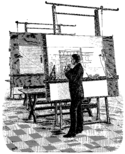Edward Durell Stone
| Edward Durell Stone | |
|---|---|
 Stone i midten. | |
| Personlig information | |
| Født | 9. marts 1902 Fayetteville |
| Død | 6. august 1978 (76 år) New York City |
| Uddannelse og virke | |
| Uddannelsessted | University of Arkansas, Harvard Universitet, Harvard Graduate School of Design, Boston Architectural College, Massachusetts Institute of Technology |
| Medlem af | American Academy of Arts and Letters |
| Beskæftigelse | Arkitekt, designer |
| Kendte værker | Memorial Gymnasium |
| Bevægelse | Postmoderne arkitektur |
| Nomineringer og priser | |
| Udmærkelser | Horatio Alger Award, Rome Prize |
| Information med symbolet | |
Edward Durell Stone (født 9. marts 1902, død 6. august 1978) var en amerikansk arkitekt.
Eksterne henvisninger
|
| Spire |
Medier brugt på denne side
Model of Electronics Research Centers first phase of construction is examined by (from left) Dr. Albert J. Kelley, Deputy Director; Edward Durell Stone, architect, of the joint venture team which designed the facilities; and Dr. Winston E. Kock, Director.
The ERC opened in September 1964, taking over the administration of contracts, grants, and other NASA business in New England from the antecedent North Eastern Operations Office (created in July 1962), and closed in June 1970. It served to develop the space agencys in-house expertise in electronics during the Apollo era. A second key function was to serve as a graduate and post- graduate training center within the framework of a regional government-industry-university alliance.
Research at the ERC was conducted in ten different laboratories: space guidance, systems, computers, instrumentation research, space optics, power conditioning and distribution, microwave radiation, electronics components, qualifications and standards, and control and information systems. Researchers investigated such areas as microwave and laser communications; the miniaturization and radiation resistance of electronic components; guidance and control systems; photovoltaic energy conversion; information display devices; instrumentation; and computers and data processing.
Although the only NASA Center ever closed, the ERC actually grew while NASA eliminated major programs and cut staff in other areas. Between 1967 and 1970, NASA cut permanent civil service workers at all Centers with one exception, the ERC, whose personnel grew annually until its closure in June 1970.Architect at his drawing board. This wood engraving was published on May 25, 1893, in Teknisk Ukeblad, Norway's leading engineering journal. It illustrates an article about a new kind of upright drawing board delivered by the firm J. M. Voith in Heidenheim a. d. Brenz (in south Germany). The board measures 1800 x 1250 mm, the total height is 2800 mm, and the weight 220 kg.


